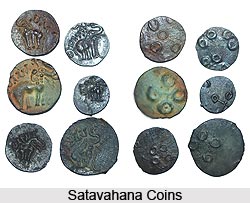 The Satavahana Kings were the Andhras who initially ruled in the area of Andhradesa between the rivers Krishna and Godavari. The Puranas mention 30 Satavahana Kings. Most of the Satavahana kings are known from their coins and inscriptions. This dynasty ruled from Junnar (Pune), Prathisthan (Paithan) in Maharashtra and Amaravati (Dharanikota) in Andhra Pradesh over Southern and Central India from around 230 BCE onward. Although there is some controversy about when the lineage of Satavahana kings came to an end, the most authentic estimates suggest that it lasted about 450 years, until around 220 CE. The Satavahana kings are credited for establishing peace in the country, resisting the assault of foreigners after the decline of Mauryan Empire.
The Satavahana Kings were the Andhras who initially ruled in the area of Andhradesa between the rivers Krishna and Godavari. The Puranas mention 30 Satavahana Kings. Most of the Satavahana kings are known from their coins and inscriptions. This dynasty ruled from Junnar (Pune), Prathisthan (Paithan) in Maharashtra and Amaravati (Dharanikota) in Andhra Pradesh over Southern and Central India from around 230 BCE onward. Although there is some controversy about when the lineage of Satavahana kings came to an end, the most authentic estimates suggest that it lasted about 450 years, until around 220 CE. The Satavahana kings are credited for establishing peace in the country, resisting the assault of foreigners after the decline of Mauryan Empire.
After becoming independent around 230 BCE, Simuka, the founder of the Satavahana dynasty, conquered Maharashtra, Andhra Pradesh, Malwa and part of Madhya Pradesh. This Satavahana king was succeeded by his brother Kanha, who further extended his kingdom to the west and the south of India. His successor Satakarni I was the sixth Satavahana king and he is said in the Puranas to have ruled for 56 years.
Satakarni defeated the Sunga dynasty of North India by wrestling and took away western Malwa from them, and performed several Vedic sacrifices at huge cost, including the Horse Sacrifice. This Satavahana king also was in conflict with the Kalinga ruler Kharavela, who mentions him in the Hathigumpha inscription. According to the Yuga Purana, this ruler conquered Kalinga following the death of Kharavela. He extended Satavahana rule over Madhya Pradesh and drove out the Sakas from Pataliputra, where he subsequently ruled for 10 years.
Many minor Satavahana kings succeeded Satakarni, such as Lambodara, Apilaka, Meghasvati and Kuntala Satakarni, who are thought to have been under the supervision of the Kanva dynasty. The Puranas (the Matsya Purana, the Vayu Purana, the Brahmanda Purana, the Vishnu Purana) all state that the first of the Satavahana kings rose to power in the 1st century BCE, by slaying Susarman, the last ruler of the Kanvas.
The first century CE saw another incursion of the Sakas of Central Asia into India, where they formed the dynasty of the Western Kshatrapas. Eventually Gautamiputra (Sri Yagna) S?takarni (also known as Shalivahan) (r. 78-106 CE) defeated the Western Satrap ruler Nahapana, thus restoring the status of his dynasty by re-conquering a major part of the former dominions of the Satavahana kings. He was an ardent supporter of Hinduism.
Several Satavahana kings divided the lands of the kingdom among themselves. Among the lands, the major belts were western Satraps, Andhra Ikshvakus (or Sr?parvatiyas) in the Krishna-Guntur region, Abhiras in the western part of the kingdom. They were ultimately to succeed the S?tav?hanas in their capital Pratishth?napura and many others.
According to the Puranas, the list of Satavahana kings is as follows -
| Simuka or Sisuka (r. 230-207 BCE), ruled 23 years. | Apilaka, ruled 12 years. | Pulomavi or Patumavi, ruled 36 years. | Sivasvati, ruled 28 years. | Canda Sri Satakarni, ruled 10 years. |
| Krishna (r. 207-189 BCE), ruled 18 years. | Meghasvati or Saudasa, ruled 18 years. | Riktavarna or Aristakarman, ruled 25 years. | Gautamiputra Satakarni, or Gautamiputra, popularly known as Shalivahan (r. 25-78 CE), ruled 21 years. | Puloma, ruled 7 years. |
| Sri Mallakarni or Sri Satakarni, ruled 10 years. | Svati or Svami, ruled 18 years. | Hala (r. 20-24 CE), author of the Gathasaptasati (Indian literature classic), ruled 5 years. | Vasisthiputra Sri Pulamavi, or Puloma, Puliman, ruled 28 years. | Madhariputra Svami Sakasena |
| Purnotsanga, ruled 18 years | Skandasvati, ruled 7 years. | Mandalaka or Bhavaka, Puttalaka, ruled 5 years. | Vashishtiputra Satakarni or Shiva Sri, Sivasri, ruled 7 years. | |
| Skandhastambhi, ruled 18 years | Mahendra Satakarni or Mrgendra Svatikarna, Satakarni II, ruled 8 years. | Purindrasena, ruled 5 years. | Shivaskanda Satakarni, ruled 7 years. | |
| Satakarni I (195 BCE), ruled 56 years | Kuntala Satakarni or Kuntala Svatikarna, ruled 8 years. | Sundara Satakarni, ruled 1 year. | Yajna Sri Satakarni, ruled 29 years. | |
| Lambodara, ruled 18 years.(r. 87-67 BCE) | Svatikarna, ruled 1 year. | Cakora Satakarni or Cakora Svatikarna, ruled 6 months. | Vijaya, ruled 6 years. |



















